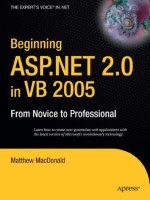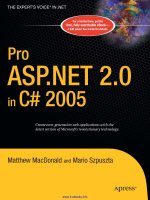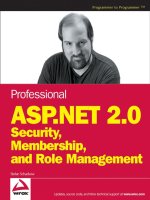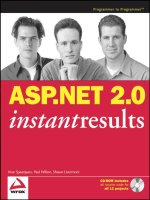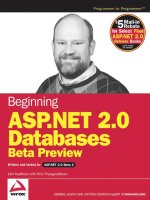asp.net 4.0 in practice
Bạn đang xem bản rút gọn của tài liệu. Xem và tải ngay bản đầy đủ của tài liệu tại đây (14.68 MB, 501 trang )
ASP.NET 4.0 in Practice
DANIELE BOCHICCHIO
STEFANO MOSTARDA
MARCO DE SANCTIS
MANNING
Shelter Island
For online information and ordering of this and other Manning books, please visit
www.manning.com. The publisher offers discounts on this book when ordered in quantity.
For more information, please contact
Special Sales Department
Manning Publications Co.
20 Baldwin Road
PO Box 261
Shelter Island, NY 11964
Email:
©2011 by Manning Publications Co. All rights reserved.
No part of this publication may be reproduced, stored in a retrieval system, or transmitted, in
any form or by means electronic, mechanical, photocopying, or otherwise, without prior written
permission of the publisher.
Many of the designations used by manufacturers and sellers to distinguish their products are
claimed as trademarks. Where those designations appear in the book, and Manning
Publications was aware of a trademark claim, the designations have been printed in initial caps
or all caps.
Recognizing the importance of preserving what has been written, it is Manning’s policy to have
the books we publish printed on acid-free paper, and we exert our best efforts to that end.
Recognizing also our responsibility to conserve the resources of our planet, Manning books are
printed on paper that is at least 15 percent recycled and processed without the use of elemental
chlorine.
Manning Publications Co. Development editor: Cynthia Kane
20 Baldwin Road Copyeditor: Joan Celmer
PO Box 261 Typesetter: Gordan Salinovic
Shelter Island, NY 11964 Cover designer: Marija Tudor
ISBN 9781935182467
Printed in the United States of America
12345678910–MAL –161514131211
v
brief contents
PART 1 ASP.NET FUNDAMENTALS 1
1 ■ Getting acquainted with ASP.NET 4.0 3
2 ■ Data access reloaded: Entity Framework 30
3 ■ Integrating Entity Framework and ASP.NET 52
PART 2 ASP.NET WEB FORMS 75
4 ■ Building the user interface with ASP.NET Web Forms 77
5 ■ Data binding in ASP.NET Web Forms 104
6 ■ Custom controls 135
7 ■ Taking control of markup 162
PART 3 ASP.NET MVC 185
8 ■ Introducing ASP.NET MVC 187
9 ■ Customizing and extending ASP.NET MVC 219
PART 4 SECURITY 257
10 ■ ASP.NET security 259
11 ■ ASP.NET authentication and authorization 282
BRIEF CONTENTS
vi
PART 5 ADVANCED TOPICS 317
12 ■ Ajax and RIAs with ASP.NET 4.0 319
13 ■ State 348
14 ■ Caching in ASP.NET 366
15 ■ Extreme ASP.NET 4.0 396
16 ■ Performance and optimizations 416
vii
contents
preface xv
acknowledgments xvii
about this book xix
about the authors xxiii
about the cover illustration xxv
PART 1 ASP.NET FUNDAMENTALS 1
1
Getting acquainted with ASP.NET 4.0 3
1.1 Meet ASP.NET 4
1.2 Typical architecture in ASP.NET applications 7
1.3 Your first ASP.NET Web Form 13
1.4 What’s new in ASP.NET 4.0 17
1.5 ASP.NET Web Forms in practice 20
TECHNIQUE 1Handling PostBack 20
TECHNIQUE 2Form validation 23
TECHNIQUE 3Page header, styling, and CSS 26
1.6 Summary 28
CONTENTS
viii
2
Data access reloaded: Entity Framework 30
2.1 Designing an application 31
2.2 Using an ORM to build a data layer 35
2.3 Introducing Entity Framework 37
TECHNIQUE 4Creating a model using Entity
Framework 38
TECHNIQUE 5 Generating POCO code 41
TECHNIQUE 6Reading data using Entity Framework 43
TECHNIQUE 7 Writing data using Entity Framework 48
2.4 Summary 51
3
Integrating Entity Framework and ASP.NET 52
3.1 Understanding context lifetime 53
TECHNIQUE 8 First approach: one context per method 53
TECHNIQUE 9A better approach: one context per ASP.NET
request 55
TECHNIQUE 10Instantiating the context using modules 58
3.2 Using the context the right way 59
TECHNIQUE 11Persisting entity modifications 60
TECHNIQUE 12Persisting only selected properties 61
TECHNIQUE 13 Persisting an entity using ViewState 65
TECHNIQUE 14Keep concurrency in mind 66
3.3 Optimizing performance in an ASP.NET environment 69
TECHNIQUE 15 Optimizing fetching 69
TECHNIQUE 16Avoiding multiple query execution 70
TECHNIQUE 17 Optimizing queries that retrieve a single
element 71
TECHNIQUE 18Disabling change tracking 73
3.4 Summary 74
PART 2 ASP.NET WEB FORMS 75
4
Building the user interface with ASP.NET Web Forms 77
4.1 The UI and Web Forms 78
TECHNIQUE 19Better markup generation in ASP.NET 4.0 81
TECHNIQUE 20Controlling ClientID generation 83
4.2 Defining a common UI: using master pages 85
TECHNIQUE 21Using nested master pages 86
TECHNIQUE 22 Setting a master page programmatically 88
CONTENTS
ix
4.3 URL rewriting and routing with ASP.NET 91
TECHNIQUE 23URL routing with Web Forms 93
TECHNIQUE 24Advanced URL routing scenarios 97
TECHNIQUE 25Rewriting in practice: UrlRewriting.NET 101
4.4 Summary 103
5
Data binding in ASP.NET Web Forms 104
5.1 Displaying data 105
TECHNIQUE 26 How to display data using Repeater 106
TECHNIQUE 27 ListView in ASP.NET 4.0 109
5.2 Modifying data 111
TECHNIQUE 28Using data source controls 111
TECHNIQUE 29EntityDataSource and Entity Framework 114
TECHNIQUE 30What’s new in GridView, FormView, and
ListView 115
5.3 Filtering and sorting data 118
TECHNIQUE 31 The QueryExtender control 118
5.4 Working with Dynamic Data controls 123
TECHNIQUE 32 The first application 123
TECHNIQUE 33Working with metadata and templates 127
TECHNIQUE 34Extending Dynamic Data 131
5.5 Summary 134
6
Custom controls 135
6.1 The basics of custom controls 136
TECHNIQUE 35Simple controls 136
TECHNIQUE 36Composite controls 139
TECHNIQUE 37Handling PostBack 144
6.2 Complex controls 147
TECHNIQUE 38 Container controls 147
TECHNIQUE 39Templated controls 149
TECHNIQUE 40Data binding in custom controls 153
6.3 Advanced controls 156
TECHNIQUE 41 Control builders 156
6.4 Summary 161
7
Taking control of markup 162
7.1 ASP.NET adaptive rendering 163
TECHNIQUE 42Add OptionGroups to DropDownList 164
TECHNIQUE 43 Build a table-less control adapter for the
DataList 170
CONTENTS
x
7.2 ASP.NET 4.0 browser capabilities 177
TECHNIQUE 44Building a custom browser capabilities
provider 178
TECHNIQUE 45Validating ASP.NET pages with the W3C
validator 182
7.3 Summary 183
PART 3 ASP.NET MVC 185
8
Introducing ASP.NET MVC 187
8.1 A new way to build web applications 188
8.2 Your first experience with ASP.NET MVC 190
TECHNIQUE 46The model 191
TECHNIQUE 47The controller 194
TECHNIQUE 48The view 197
8.3 Routing in ASP.NET MVC 200
TECHNIQUE 49Partitioning using Areas 204
8.4 Accepting user input 207
TECHNIQUE 50 Handling user input at the controller
level 207
TECHNIQUE 51 Validating posted data 212
8.5 Summary 217
9
Customizing and extending ASP.NET MVC 219
9.1 Building reusable elements in ASP.NET MVC 220
TECHNIQUE 52Building customized data templates 221
TECHNIQUE 53 Componentized markup through HTML
helpers 226
TECHNIQUE 54Inject logic using action filters 229
9.2 User input handling made smart 235
TECHNIQUE 55 Custom model binders for domain
entities 236
TECHNIQUE 56 Building a new model binder from
scratch 243
9.3 Improving ASP.NET MVC routing 249
TECHNIQUE 57 Routes with consistent URL termination 249
9.4 Summary 255
CONTENTS
xi
PART 4 SECURITY 257
10
ASP.NET security 259
10.1 What is security in ASP.NET applications? 260
10.2 Filtering and blocking incoming requests 262
TECHNIQUE 58Handling improper parameter values 263
TECHNIQUE 59 Monitoring and blocking bad requests 264
10.3 Protecting applications from SQL injection 266
TECHNIQUE 60Handling SQL queries using parameters 267
TECHNIQUE 61 Dynamic queries with multiple values 269
10.4 Dealing with XSS (cross-site scripting) 271
TECHNIQUE 62 Handling and displaying user input 271
TECHNIQUE 63Using Microsoft’s Anti-XSS Library 275
10.5 Controlling path composition: path canonicalization
vulnerabilities 278
TECHNIQUE 64 Dynamically building a path 278
10.6 Summary 281
11
ASP.NET authentication and authorization 282
11.1 Authentication and authorization basics 283
TECHNIQUE 65 Using FormsAuthentication and
UrlAuthorization 284
11.2 Handling user authentication: introducing the Membership
API 288
TECHNIQUE 66 Implementing a user login using the Membership
API 289
11.3 Adding support to roles using the Roles API 294
TECHNIQUE 67 Implementing a role-enabled login using Roles
API 294
11.4 Custom providers for the Membership and Roles APIs 298
TECHNIQUE 68 Other providers 298
TECHNIQUE 69 Building custom Membership and Role
providers 300
TECHNIQUE 70Integrating Windows Live ID with your
application 309
11.5 Summary 315
CONTENTS
xii
PART 5 ADVANCED TOPICS 317
12
Ajax and RIAs with ASP.NET 4.0 319
12.1 Understanding Ajax 320
12.2 Working with ASP.NET Ajax 323
TECHNIQUE 71Creating a classic page 323
TECHNIQUE 72 Ajaxize a page using the update
panel 324
TECHNIQUE 73Optimizing UpdatePanel using
triggers 326
TECHNIQUE 74 Optimizing a page with multiple
UpdatePanels 327
TECHNIQUE 75Intercepting client-side pipeline 328
12.3 Focusing on the client: jQuery 330
TECHNIQUE 76Invoking REST web services with
jQuery 336
TECHNIQUE 77 Invoking page methods with
jQuery 339
TECHNIQUE 78 Invoking MVC actions with
jQuery 341
TECHNIQUE 79Enriching the interface via
jQueryUI 342
12.4 Summary 347
13
State 348
13.1 Handling state 349
TECHNIQUE 80Per-request state 349
TECHNIQUE 81Per-session state 351
13.2 Advanced user state 354
TECHNIQUE 82Using the Profile API 355
TECHNIQUE 83 A custom provider for the Profile API 359
13.3 Summary 365
14
Caching in ASP.NET 366
14.1 Per-application state: Cache 367
14.2 Using OutputCache 368
TECHNIQUE 84Leveraging OutputCache to speed up your
pages 368
CONTENTS
xiii
14.3 OutputCache in ASP.NET MVC 371
TECHNIQUE 85Deterministically removing items from
OutputCache 372
TECHNIQUE 86OutputCache and partial views 378
14.4 Data caching techniques 381
TECHNIQUE 87Implementing data caching in
ASP.NET 381
14.5 Building custom cache providers 386
TECHNIQUE 88 Custom cache provider 388
TECHNIQUE 89 Custom OutputCache provider 393
14.6 Summary 395
15
Extreme ASP.NET 4.0 396
15.1 Using HttpModules 397
TECHNIQUE 90Modifying the response flow with
HttpModules 398
TECHNIQUE 91Intercepting and handling mobile device
requests 400
15.2 Logging and handling errors 402
TECHNIQUE 92 Intercepting, and handling errors with a custom
module 403
15.3 Extending ASP.NET HttpRuntime 407
TECHNIQUE 93Running your site from the database 407
15.4 Summary 415
16
Performance and optimizations 416
16.1 Increasing download performance by minifying 417
TECHNIQUE 94 Building a request filter to minify HTML 417
TECHNIQUE 95Building an HTTPHandler to minify CSS 422
TECHNIQUE 96Building an HTTPHandler to minify
JavaScript 425
16.2 Reducing computing time with multithreading 426
TECHNIQUE 97 Increasing performance with
multithreading 427
TECHNIQUE 98Using ParallelFX 435
16.3 Optimize your web.config 438
TECHNIQUE 99Tips for your web.config 438
16.4 Summary 439
CONTENTS
xiv
appendix A ASP.NET and IIS 7.x 441
TECHNIQUE 100 Modifying IIS behavior with managed
modules 443
TECHNIQUE 101 Configuring application warm-up in IIS 7.5 445
appendix B Data access fundamentals 448
TECHNIQUE 102 UsiQuerying the database using ADO.NET 449
TECHNIQUE 103 Using stored procedures to query the
database 452
TECHNIQUE 104 Persisting data into the database 453
TECHNIQUE 105 Writing XML 456
TECHNIQUE 106 Generating XML from a data source 458
TECHNIQUE 107 Reading XML 459
index 463
xv
preface
This has been a very long journey. We found that writing this book was a challenging
task, a much harder one than we had anticipated, but there were also moments of joy
and discovery along the way! The idea for the book first came to us 18 months ago,
and many days and nights have come and gone between the first sentence we wrote
and the final book you hold today.
This is not our first book—it is the ninth book for Daniele, the seventh for Stefano,
and the fourth for Marco—but it is the most complex one we’ve attempted because of
the Techniques format we implement in the book. In addition, we were coauthoring
another book for Manning Publications, Entity Framework 4 in Action, at roughly the
same time.
Our aim in writing this book was not to create a typical reference book: there are
plenty of those around. We felt that because
ASP.NET has now reached a high level of
maturity, the time was ripe for a book of best practices, and that is what we set out to
do. Instead of focusing on how a class is implemented or what members offer, this
book shows you how to get tasks done, the right way.
If your days (and nights) are spent on implementing web applications, you know
that the best way to learn is from experience. This book contains all the tips we have
learned in more than 10 years of working with
ASP.NET. Everything in this book comes
from our own day-by-day experience working as consultants as well from ASP.NET com-
munity members. We learned a lot from other people’s problems, and we are happy to
now share the solutions and best practices with you.
PREFACE
xvi
In this book you will find everything you need to build your web applications using
a Problem/Solution/Discussion approach. Each scenario is motivated, then resolved,
and finally discussed and explained.
This is a book that we felt was missing from the market. We hope we have filled
that need successfully and we invite you to send us your feedback and let us know if we
have been successful in attaining our goal.
We hope that our efforts will help you in your daily work. Enjoy the read, get your
hands dirty, and have some fun!
xvii
acknowledgments
We can’t mention by name all the individuals who made contributions to this book,
adding to its value in ways both large and small. All of them deserve our sincere
thanks, but here we will mention only a few whose help was invaluable to us during
the writing process.
Cynthia Kane—Cynthia is our development editor at Manning. She was there for
us from the the beginning, providing support and guidance, and has proved a master
at transforming a bunch of words and images into an appealing book. Thank you.
Scott Guthrie—Scott, also known as ScottGu, is the man behind a number of prod-
ucts in the Microsoft Developer Division, including
ASP.NET. Scott was always willing to
let us solve some of the problems that we encountered with a beta. Thank you.
The Developer Division at Microsoft—thanks to everyone for their help and for
building such a great product.
All the folks at
ASPItalia.com, our “mother ship”—if we managed to collect enough
scenarios for your problem-solving enjoyment, part of the credit has to go to the mem-
bers of our community.
Many individuals at Manning worked hard on this book to bring it to our readers.
A big thank-you to Michael Stephens and Marjan Bace for believing in us, and to the
production team of Mary Piergies, Joan Celmer, Susan Harkins, Gordan Salinovic, and
Janet Vail for their efforts.
Our peer reviewers deserve special mention. Their suggestions and feedback were
invaluable and made this a much better book. We thank Alex Thissen, Dave Corun,
Anil Radhakrishna, Philippe Vialatte, Nikander Bruggeman, Margriet Bruggeman,
ACKNOWLEDGMENTS
xviii
Jason Jung, David Barkol, Perga Massimo, Braj Panda, Alessandro Gallo, Gary Bushey,
Eric Swanson, Amos Bannister, and Andrew Siemer. We would also like to thank the
technical proofreader, Matteo Casati, for his outstanding job of reviewing the final
manuscript during production.
Last but not least, thank you, dear reader, for your trust in this book. Our hope is that
it will help you in your day-to-day work and make you more productive with
ASP.NET!
In addition to the people mentioned above, there are others who are important in
Daniele’s, Stefano’s, and Marco’s private lives. Even if they didn’t directly work on the
book, they contributed in other important ways to keep the authors on track.
Daniele would like to thank his wife Noemi for her support and patience and for giving
him his beautiful sons, Alessio and Matteo. A big thank-you to my parents for letting
me play with computers when I was a kid, and to my family in general for supporting
me. A special thank-you to my coauthors for helping me on this journey: you guys rock!
And thanks to Alessio, Marco, Cristian, Matteo, and Riccardo at
ASPItalia.com for all
their help and support.
Stefano wants to thank his wife Sara for being supportive and extremely patient, and
his family (yes, the book is finally finished!). Special thanks to my closest friends (in
alphabetical order), Federico, Gabriele, Gianni, and Riccardo. Of course, I can’t help
mentioning Filippo, who already bought a copy of the book. Finally, a big thank-you to
William and Annalisa for their friendship and their support. My last words are for
Marco and Daniele: thanks guys!
Marco thanks Stefano and Daniele because it’s always a privilege when you have the
chance to work with such smart and funny guys. I would also like to thank the whole
ASPItalia.com team: I’m so proud to be a part of it. Special thanks to my family, and to
Barbara, for their support and for the patience they’ve shown me. You have all my love.
xix
about this book
ASP.NET is a Microsoft technology for building web applications that leverages all the
fantastic technologies you can find in .NET Framework.
The book will move you from apprentice to master of ASP.NET by giving you spe-
cific techniques to solve problems you are likely to encounter. Each technique has a
problem, solution, and discussion section. You might think of this book as a guided
tour through
ASP.NET best practices; we’ll introduce each scenario, solve the problem,
and then discuss the results. Once you’ve read this book, you’ll have a better under-
standing of the most important aspects of designing, building, and maintaining
ASP.NET-based applications.
You’re going to find many devices in this book that will help you in the learning
process:
■
Figures—Pictures that show a workflow or summarize concepts
■
Listings and snippets—Pieces of code that show the solution to a problem
■
Tables—Visuals that summarize a list of features or options
We hope these devices will help make concepts clearer and the learning process faster.
Who should read this book?
This book targets developers who are working on everything from the smallest home
application to the largest enterprise application. ASP.NET can be useful in simple sce-
narios, where you can apply most of the RAD features provided by Visual Studio 2010,
ABOUT THIS BOOK
xx
as well as in enterprise applications, where its roots in .NET Framework offer a wider
range of possibilities.
Roadmap
This book is designed for you to improve your ASP.NET expertise and is organized into
sixteen chapters divided into five parts and two appendixes.
Part 1: ASP.NET fundamentals
In part 1, we introduce ASP.NET fundamentals. For those of you who are already some-
what familiar with ASP.NET, this part serves as a refresher before moving forward.
Chapter 1 provides an introduction to ASP.NET, with a focus on the Web Form’s
model.
Chapters 2 and 3 cover data access strategies in web applications. You’ll learn the
best practices for data access and how to leverage them in your application.
Part 2: ASP.NET Web Forms
Part 2 covers how to use ASP.NET Web Forms, the original model provided in ASP.NET
to build the user interface.
Chapter 4 takes a tour into ASP.NET Web Forms, covering the most common sce-
narios. You’ll also learn about the new features offered by version 4.0, how to use mas-
ter pages to their fullest extent, and how to leverage
URL routing.
Chapter 5 deals with one of the most common activities for a developer: using data
binding and how to fully integrate this feature into your applications.
Chapter 6 covers an important extensibility point in
ASP.NET Web Forms and shows
how to build custom controls. You’ll start with the basics and analyze complex scenarios.
Finally, chapter 7 explains how to control the markup generated by
ASP.NET. You’ll
learn how to produce better markup and how adaptive rendering works.
Part 3: ASP.NET MVC
In part 3, we investigate the option to build your UI with ASP.NET MVC; after all, Web
Forms aren’t the only model you can use to do that.
ASP.NET MVC is a new option added in ASP.NET 3.5 SP1 and directly integrated
into ASP.NET 4.0 as ASP.NET MVC 2.0. It’s not the new Web Forms, but rather a dif-
ferent approach to solve the same problem. ASP.NET MVC lets you use the Model-
View-Controller (MVC) pattern, and is built with testability and great markup con-
trol in mind.
Chapter 8 contains an introduction to
ASP.NET MVC and shows the potential that
this new toolkit offers when you’re building the UI. You’ll learn how to perform the
basic actions that you’re already acquainted with in ASP.NET Web Forms.
Chapter 9 covers how to customize and extend ASP.NET MVC in order to unlock
the full potential that it offers.
ABOUT THIS BOOK
xxi
Part 4: Security
In part 4, we take a look at one of the most important concerns of every web applica-
tion: how to protect and make your code secure.
In chapter 10, we analyze the most common issues when dealing with security.
You’ll learn how to build stronger applications, how to avoid common errors, and how
to preserve your application’s integrity. You’ll find plenty of helpful suggestions
throughout the chapter.
Chapter 11 covers authentication and authorization in
ASP.NET. It will show you
how to build a secure area, how to leverage ASP.NET’s infrastructure, and how to build
a custom provider to extend the existing features provided by ASP.NET’s Membership
and Roles APIs.
Part 5: Advanced topics
Finally, part 5 is dedicated to more advanced scenarios and combines many of the top-
ics previously addressed in this book. These chapters cover both ASP.NET Web Forms
and MVC.
Chapter 12 covers how to integrate an ASP.NET application into an Ajax-enabled
application and RIAs (Rich Internet Applications). We’ll also take a look at how to
leverage jQuery and ASP.NET Ajax.
In chapter 13, you’ll learn how to handle state in ASP.NET—from cookies, to
ViewState, to new features introduced in version 4, like the ability to compress the
SessionState
.
Chapter 14 is dedicated to caching. You’ll find plenty of tips on how to achieve bet-
ter scalability by implementing a good caching strategy. You’ll also learn how to build
custom cache providers and how Microsoft AppFabric caching works.
Chapter 15 contains miscellaneous topics related to fully extending
ASP.NET, from
HttpRuntime
, to logging, to building a virtual path provider.
Last, chapter 16 offers some tips on how to build applications that perform better,
with topics like content minifying, multithreading, and Parallel
FX.
Code conventions and downloads
All the code used in this book is in a
monospace
font like this
. The .NET code is in
both C# and Visual Basic so that you’re comfortable with the code, regardless of the
language you are using. The language is indicated immediately above the relevant
code. For longer lines of code, a wrapping character might be used so the code is
technically correct while conforming to the limitations of a printed page. Code anno-
tations accompany many of the listings, highlighting important concepts. In some
cases, numbered bullets link to explanations that follow the listing.
Source code for all working examples in this book is available for download from
the publisher’s website at www.manning.com/
ASP.NET4.0inPractice.
ABOUT THIS BOOK
xxii
Author Online
The purchase of ASP.NET 4.0 in Practice includes free access to a private forum run by
Manning Publications where you can make comments about the book, ask technical
questions, and receive help from the authors and other users. You can access and sub-
scribe to the forum at www.manning.com/
ASP.NET4.0inPractice. This page provides
information on how to get on the forum after you’re registered, what kind of help is
available, and the rules of conduct in the forum.
Manning’s commitment to our readers is to provide a venue where a meaningful
dialogue between individual readers and between readers and the authors can take
place. It isn’t a commitment to any specific amount of participation on the part of the
authors, whose contributions to the book’s forum remain voluntary (and unpaid). We
suggest you try asking the authors some challenging questions, lest their interest stray!
The Author Online forum and the archives of previous discussions will be accessible
from the publisher’s website as long as the book is in print.
In addition to the Author Online forum available on Manning’s website, you can
also contact us regarding this book, or anything else, through one of the following
avenues:
■
Book website— />■
Daniele’s blog— />■
Stefano’s blog— />■
Marco’s blog— />All comments sent to these blogs are moderated. We post nearly all comments; but if
you include your email address or phone number, we won’t post the comment out of
respect for your privacy.
xxiii
about the authors
DANIELE BOCHICCHIO is the cofounder of 5DLabs.it, a consulting agency specializing in
ASP.NET, Silverlight, Windows Phone 7, and .NET Framework. He has worked on a lot
of cool projects with many different technologies. Daniele is a well-known speaker and
author, and you can find him at the main developer-focused events worldwide. He has
also written several books, in both Italian and English. He’s the coauthor of Manning’s
Entity Framework 4 in Action. Daniele is the network manager of
ASPItalia.com, the larg-
est Italian .NET Framework community. He currently lives in southern Italy with his
family. You can reach him via his personal website at www.bochicchio.com/. Daniele
shares his thoughts in 140 characters or less at />STEFANO MOSTARDA is a Microsoft MVP in the Data Platform category. He’s a software
architect focused on web applications and the cofounder of 5DLabs.it, a consulting
agency specialized in ASP.NET, Silverlight, Windows Phone 7, and .NET Framework.
Stefano is a professional speaker at many important Italian conferences and a well-
known author. He has written many books for the Italian market and is the lead
author of Manning’s Entity Framework 4 in Action. He’s also one of the leaders of the
ASPItalia.com Network and a content manager of the LINQItalia.com website dedi-
cated to LINQ and Entity Framework. In addition to visiting his blog, you can read his
technical deliriums at />MARCO DE SANCTIS is a Microsoft MVP who has been designing and developing enter-
prise applications in distributed scenarios for the last seven years. He started develop-
ing with
ASP.NET when it was first released; since then, he’s improved his skills to
ABOUT THE AUTHORS
xxiv
become an application architect. Over the years, he has specialized in building distrib-
uted services and has widened his knowledge to encompass technologies like Work-
flow Foundation, Windows Communication Foundation,
LINQ, and ADO.NET Entity
Framework. Today Marco is one of the members of 5DLabs.it and works as a senior
software engineer for one of the biggest Italian companies in the IT market. In his
spare time, he’s a content manager at ASPItalia.com. He shares his tweets at http://
twitter.com/crad77.
xxv
about the cover illustration
The figure on the cover of ASP.NET 4.0 in Practice is captioned “Young woman from
Montenegro.” The illustration is taken from a collection of hand-colored drawings of
Dalmatian regional dress costumes from the nineteenth century titled Dalmacja. The
historical region of Dalmatia was much larger than it is today, stretching from the
Istrian Peninsula to Albania along the Adriatic coast. Today, the region is divided
between Croatia and Montenergo, the latter administering a small southernmost sec-
tion. The long, rugged Dalmatian coast, backed by high mountains with hundreds of
offshore islands, is fast becoming one of Europe’s most popular vacation spots.
The young woman on the cover is wearing a costume typical for the villages and
small towns found in this region. Rich embroidery, handmade linens, and colorful
woolen scarves and skirts are the traditional elements of a Dalmatian costume, with
small, not easily discernible decorative details indicating the locality of origin.
Dress codes and lifestyles have changed over the last 200 years, and the diversity by
region, so rich at the time, has faded away. It is now hard to tell apart the inhabitants
of different continents, let alone of different hamlets or towns separated by only a few
miles. Perhaps we have traded cultural diversity for a more varied personal life—cer-
tainly for a more varied and fast-paced technological life.
Manning celebrates the inventiveness and initiative of the computer business with
book covers based on the rich diversity of regional life of two centuries ago, brought
back to life by illustrations from old books and collections like this one.
Part 1
ASP.NET Fundamentals
Welcome to ASP.NET 4.0 In Practice, dear reader!
ASP.NET was first introduced in the early 2000s as an effort from Microsoft to
bring the easy development typical of Windows applications to the web. From
this first attempt, the web has changed a lot and so has
ASP.NET. Now ASP.NET is
a mature framework that lets you create powerful applications.
This book is divided into four parts. Part 1 is going to give you a jump start
into the fundamentals of
ASP.NET. If you’re an average developer who wants to
put things in context, consider this part a quick refresher course. If you’re new
to
ASP.NET, you’ll get all the basics you need.
Chapter 1 is a general introduction to ASP.NET, specifically to the Web Form’s
model.
Chapters 2 and 3 cover data access strategies in web applications. You’ll learn
best practices for data access and how to leverage them in your applications.


